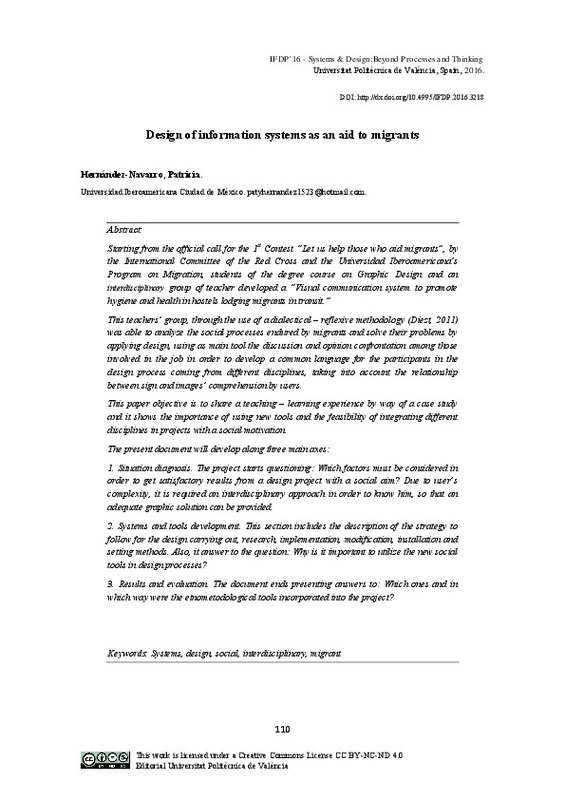JavaScript is disabled for your browser. Some features of this site may not work without it.
Buscar en RiuNet
Listar
Mi cuenta
Estadísticas
Ayuda RiuNet
Admin. UPV
Design of information systems as an aid to migrants
Mostrar el registro sencillo del ítem
Ficheros en el ítem
| dc.contributor.author | Hernández Navarro, Patricia
|
es_ES |
| dc.date.accessioned | 2017-09-20T06:33:25Z | |
| dc.date.available | 2017-09-20T06:33:25Z | |
| dc.date.issued | 2016-10-27 | |
| dc.identifier.isbn | 9788490484401 | |
| dc.identifier.uri | http://hdl.handle.net/10251/87557 | |
| dc.description.abstract | [EN] Starting from the official call for the 1st Contest “Let us help those who aid migrants”, by the International Committee of the Red Cross and the Universidad Iberoamericana’s Program on Migration, students of the degree course on Graphic Design and an interdisciplinary group of teacher developed a “Visual communication system to promote hygiene and health in hostels lodging migrants in transit.” This teachers’ group, through the use of a dialectical – reflexive methodology (Diezt, 2011) was able to analyze the social processes endured by migrants and solve their problems by applying design, using as main tool the discussion and opinion confrontation among those involved in the job in order to develop a common language for the participants in the design process coming from different disciplines, taking into account the relationship between sign and images’ comprehension by users. This paper objective is to share a teaching – learning experience by way of a case study and it shows the importance of using new tools and the feasibility of integrating different disciplines in projects with a social motivation. The present document will develop along three main axes: 1. Situation diagnosis. The project starts questioning: Which factors must be considered in order to get satisfactory results from a design project with a social aim? Due to user’s complexity, it is required an interdisciplinary approach in order to know him, so that an adequate graphic solution can be provided. 2. Systems and tools development. This section includes the description of the strategy to follow for the design carrying out, research, implementation, modification, installation and setting methods. Also, it answer to the question: Why is it important to utilize the new social tools in design processes? 3. Results and evaluation. The document ends presenting answers to: Which ones and in which way were the etnometodological tools incorporated into the project? | es_ES |
| dc.format.extent | 8 | es_ES |
| dc.language | Inglés | es_ES |
| dc.publisher | Editorial Universitat Politècnica de València | es_ES |
| dc.relation.ispartof | Systems&design:beyond processes and thinking | es_ES |
| dc.rights | Reconocimiento - No comercial - Sin obra derivada (by-nc-nd) | es_ES |
| dc.subject | Systems, design | es_ES |
| dc.subject | Social | es_ES |
| dc.subject | Interdisciplinary | es_ES |
| dc.subject | Migrant | es_ES |
| dc.title | Design of information systems as an aid to migrants | es_ES |
| dc.type | Capítulo de libro | es_ES |
| dc.type | Comunicación en congreso | es_ES |
| dc.identifier.doi | 10.4995/IFDP.2015.3218 | |
| dc.rights.accessRights | Abierto | es_ES |
| dc.description.bibliographicCitation | Hernández Navarro, P. (2016). Design of information systems as an aid to migrants. En Systems&design:beyond processes and thinking. Editorial Universitat Politècnica de València. 110-117. https://doi.org/10.4995/IFDP.2015.3218 | es_ES |
| dc.description.accrualMethod | OCS | es_ES |
| dc.relation.conferencename | Systems & Design: Beyond Processes and Thinking | es_ES |
| dc.relation.conferencedate | June 22-24,2016 | es_ES |
| dc.relation.conferenceplace | Valencia, Spain | es_ES |
| dc.relation.publisherversion | http://ocs.editorial.upv.es/index.php/IFDP/IFDP/paper/view/3218 | es_ES |
| dc.description.upvformatpinicio | 110 | es_ES |
| dc.description.upvformatpfin | 117 | es_ES |
| dc.type.version | info:eu-repo/semantics/publishedVersion | es_ES |
| dc.relation.pasarela | OCS\3218 | es_ES |








